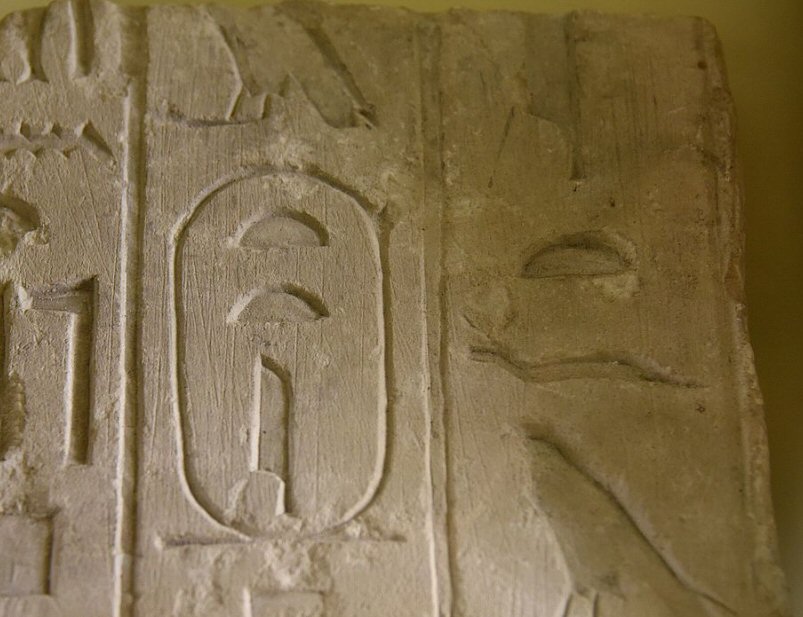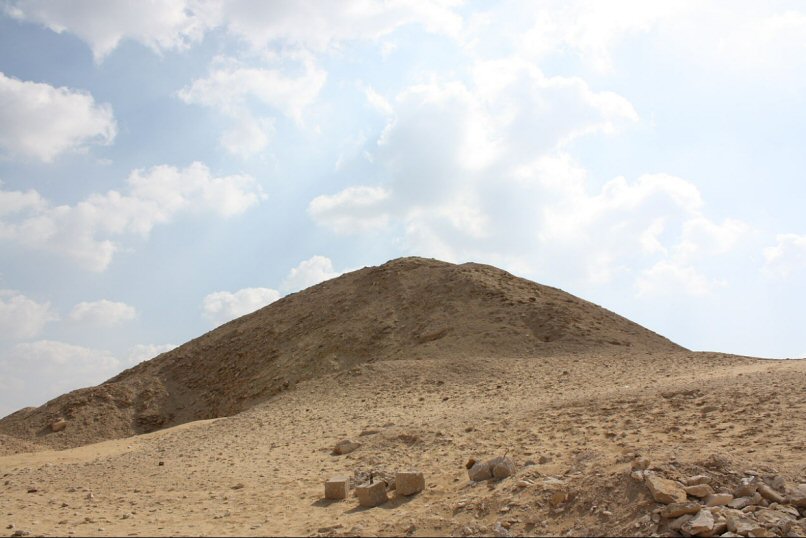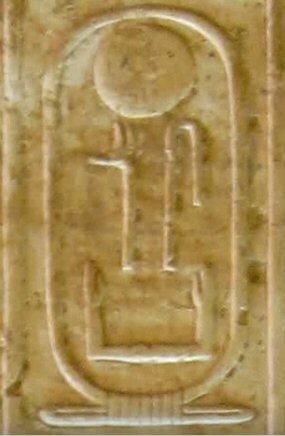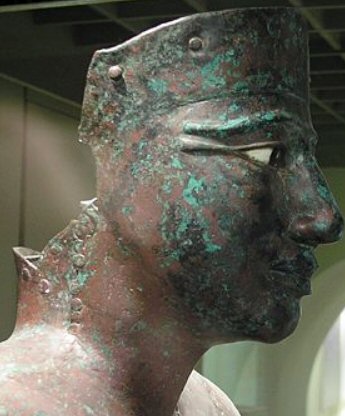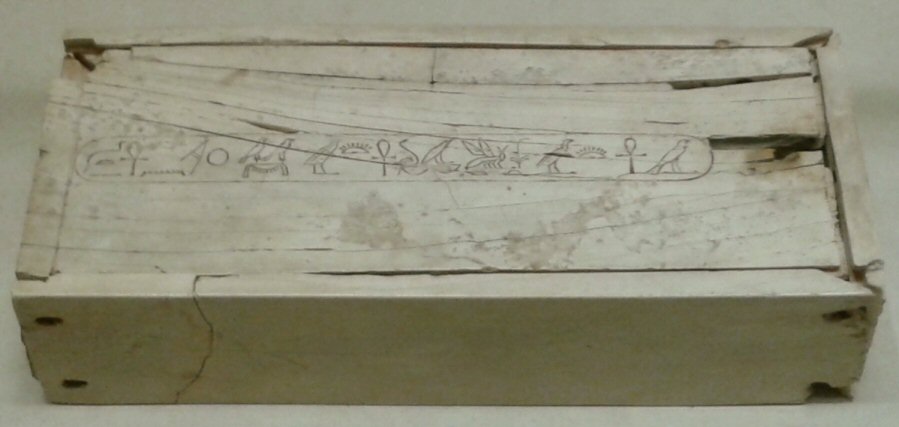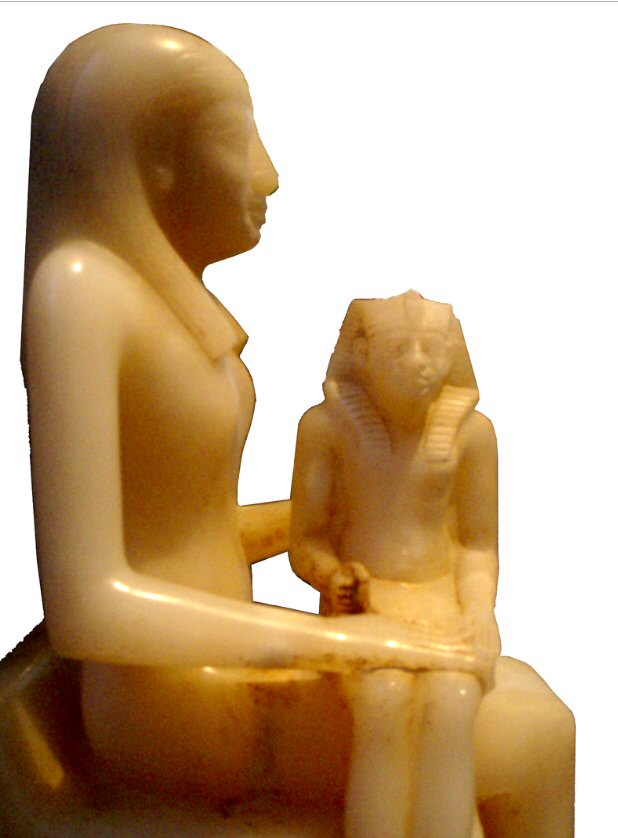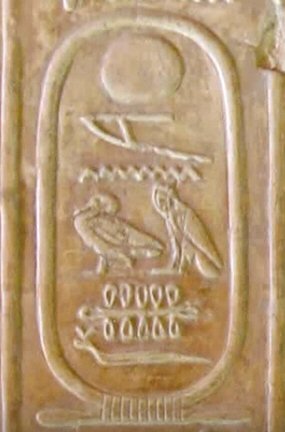Pepi I
With the rise of this dynasty, and especially at the time of Pepy I, the position of the priesthood of the Sun-god Re was still noticeable and also the priests of god Ptah raised in their prominence, to the extent that it has been suggested that King Teti, the founder of the Dynasty, came from Memphis, whose main deity was god Ptah.
His Hours name is 'Sehetep-tawy' which means "He who pacifies the Two Lands'. That was an indication to the political program he followed.Teti seems to have made no break with the preceding dynasty. He married a daughter of Wenis, Iput, who was to be the mother of Pepi I.
Teti was faithful to Wenis, as he finished some constructional works for him.He also applied a policy of cooperation with the nobles by making his eldest daughter, Sesheshet, marry his vizier Mereruka. Mereruka later also became the chief priest of Teti's pyramid complex, and had himself been buried close to Teti's pyramid in one of the finest mastabas of Northern Saqqara site.
The pyramid that Teti ordered to be constructed at Saqqara, which was the second one after Wenis' to be inscribed in the Pyramid Texts, represented a return to certain Fourth-Dynasty traditions. He reintroduced the construction of queens' pyramids, whereas Wenis had been content to provide mastabas for his wives. The remains of Iput were found in a small pyramid built about 100 m north-west of her husband's tomb.
There is some evidence at Abydos of his activity as a legislator in the form of a decree exempting the temple from tax. He was also the first ruler to be particularly associated with the cult of Hathor at Dendera.
The internal stability of the country's administration is suggested by the fact that he was able to continue many of the international links of the Fifth Dynasty: he maintained relations with Byblos and perhaps also with Punt and Nubia.
The Turin Canon gives an unlikely estimate of less than seven months as the length of his reign. Manetho suggests a long period of 30 to 33 years, which is again unlikely considering that there is no evidence for him having celebrated a jubilee festival. Manetho says that Teti was assassinated, which may have led to the civil disorder.
Userkare
His name means 'the Ka of Re is Powerful'. He is not completely an unknown figure. Rather, he is not only mentioned in the Turin Canon and the Abydos King-List, but various other documents bearing his name had survived as well. One text mentions a team of salaried workers from the nome of Kau el-Kebir, south of Asyut, who were engaged in a large-scale project –no doubt the construction of his tomb.
Perhaps Userkare should in fact be regarded as a stopgap ruler who would have overseen the regency of Queen Iput, Teti's widow, while her son was still too young to come to the throne.
Pepi I
The length of Pepi I's reign extended over about 50 years according to both Manetho and the Turin Canon, and in reality it must have been at least 40 years, which suggests that he was very young when he came to the throne at the end of his mother's regency.
His Horus name was 'Mery-tawy' which means "He who is loved by the Two Lands", which indicates his desire for political appeasement.
An important event took place during his time. There seems to have been a conspiracy against the King in his harem, ending in the punishment of the guilty wife and also apparently of the son for whom she committed the crime. The evidence in question is provided by an official called Weni, in the form of an autobiography which he had inscribed in his funerary chapel at Abydos. Weni served under the reign of the first three pharaohs of the Sixth Dynasty.
He passed from the administration to the army, then after a royal funerary endowment, he led a series of great works, from the exploitation to the cutting of canal at the First Cataract. This same conspiracy seems to have found an echo in the last third of the reign: in the 21st year the king married two daughters - one after another -of Khui, a noble from Abydos. These two queens, both renamed Ankhenesmerire which means "Merire lives for her", gave him children. Ankhenesmerire I was the mother of Merenre and Princess Neith, who later married her half-brother Pepi II, the son of Ankhenesmerire II. It is tempting to link Pepi I's late remarriage to the two daughters of Khui with the harem conspiracy, in view of the fact that it was these wives who gave birth to his successors and that the remarriage itself was evidently accompanied by a change in policy.
Green and Quibell discovered two copper statues, now displayed in the Egyptian Museum at Cairo, the larger of which is a life-size representation of Pepi I while the other is a much smaller representation probably of Merenre who would be the heir to the throne.
Pepi I changed his coronation name from Neferdjahor to Merire that means "the Beloved of Re". He also issued, in the 21st year of his reign, an order awarding tax immunity to the town that had grown up around Sneferu's funerary domain at Dahshur. His own 'pyramid town', established near the temple of Ptah in the capital, was called Mennefer-Pepy, which eventually became the name of the whole city of Memphis from the Eignteenth Dynasty onwards. His pyramid was constructed at Saqqara. On its inner walls, are inscribed the Pyramid Texts. He also had many temples built at Tell Basta, Abydos, Denderah, Elephantine, and Sinai and on the island of Suhel, and Tomas in the Lower Nubia.
From the autobiography of Weni, we know of the King's suppressing expeditions against the Nubians and the Palestinians.
We also know that Pepy I married the daughter of the ruler of Abydos, who was the mother of Merenre who followed the king on the throne.
Merenre I
His name means "Beloved of Re". His coronation name Antiemdjaf 'Anti clearly shows the links he set up with Upper Egypt: Anti was a Falcon-god of war worshipped in the region stretching from the 12th to the 18th nome of Upper Egypt and particularly at Deir el-Gebrawi.
Merenre rose to the throne at an early age and he died young after a reign of only about 9 years. His half-brother Pepy II was only about 10 when he succeeded him to the throne.
The unfinished state of Merenre's pyramid, which he had built close to that of his father at Southern Saqqara, confirms that the death of Merenre was premature but it is still difficult to give his precise age at death. Within the tomb chamber, the body of a young man was discovered, but this was probably a later reuse of the tomb, since the unfinished chamber would have been easily entered by robbers and eventually reused for a new burial.
Merenre followed a policy similar to that of his father. In the economic sphere, he continued to exploit the mines in Sinai, the quarries in Nubia, Aswan, Hatnub where a graffito confirms the expeditions. The materials extracted from these quarries were necessary for the construction of his pyramid.
Merenre's activities outside Egypt represented a high point in the Sixth Dynasty. He sent expeditions to Syria and Palestine, led by Weni, who was rewarded by the governorship of Upper Egypt. He had a policy of Egyptian expansion into Nubia. He sent officials to maintain Egyptian rule over Nubia from the northern border to the area south of the Third Cataract. Lower Nubia was above all a fertile land. It was on its land that the Kerma Culture and the Kingdom of Kush were later to develop. This was the land that would supply the Egyptians with many of those exotic foodstuffs which were also imported from the land of Punt, to the east of the Nile. Merenre achieved the subjugation of the chiefs of Lower Nubia by the 10th year of his reign.
Local Governers
Harkhuf, a governor of Aswan buried at Qubbet el-Hawa, opposite to the town of Aswan, undertook three missions of this type. He tells in his autobiography, inscribed on the facade of his tomb, how he twice reached the land of Yam – which means "by the Elephantine Route". On the third time, however, he went by another way.
Later on, Pepy II adopted a policy of pacification in Nubia. He was given the help of Pepynakht, nicknamed Heqaib that means "He who is Master of his Heart", who was Harkhuf's successor and was also buried in a tomb at Qubbet el-Hawa. Heqaib led a campaign to bring back the body of an official killed on a mission in the area of Byblos where he had been sent to build a Byblos fleet in order to sail to Punt. He also led two expeditions into Nubia. It was perhaps these foreign campaigns as much as his energetic administration that led to Heqaib's deification very soon after his death. On the island of Elephantine, he had his own cult centre.
The deification of such local heroes as Heqaib at Elephantine and the vizier Isi at Edfu were probably a reflection of the great increase in the power of local administrators that was to mark the end of the dynasty. The growing power of local officials was a major factor in the decline of the Egyptian state. As Pepy II's reign advanced, these officials were gradually becoming local rulers in their own right. At the same time, foreign policy was becoming a heavier burden. The maintenance of order in Nubia had been difficult during the time of Heqaib, and even for some of his successors.
Pepi II
He is thought to have ruled the country for 94 years. During the first years of his reign, still being a child, his mother was his regent and his Uncle Gau and his vizier had the upper hand on the country's affairs.
He sent expeditions to the South, led by the governors of Elephantine, the most famous of which were Harkhuf, Pepy-nakht, Mekhu and Ny-sab.
The wealth of the local rulers is apparent in the provincial necropolises at Cusae, Akhmim, Abydos, Edfu and Elephantine.
The exceptional length of Pepy II Reign resulted not only in the gradual disintegration of the administration system but also in a succession crisis.
Merenre II
The Abydos King-List mentions Merenre II who seems to have been a son of Pepy II and Queen Neith.He ruled for only a single year, and would have been married to Queen Nitocris, who according to Manetho, was the last Sixth Dynasty ruler.
Nitocris (Nitoqret)
The Turin Canon lists Nitocris immediately after Merenre II, describing her as the "King of Upper and Lower Egypt". This woman –whose fame grew in the Ptolemaic Period under the name of the legendary Rhodopis, a mythical builder of the Third Dynasty pyramid at Giza – was the first known queen to exercise political power over Egypt.According to Manetho, she ruled for 2 years.Unfortunately, no archaeological evidence has survived either from her reign or from the time of her possible successor, Neferkare, the son of Ankhesenpepy and Pepy II. By this comes the end of one of Egypt's most glorious times, the time of the Old Kingdom.
